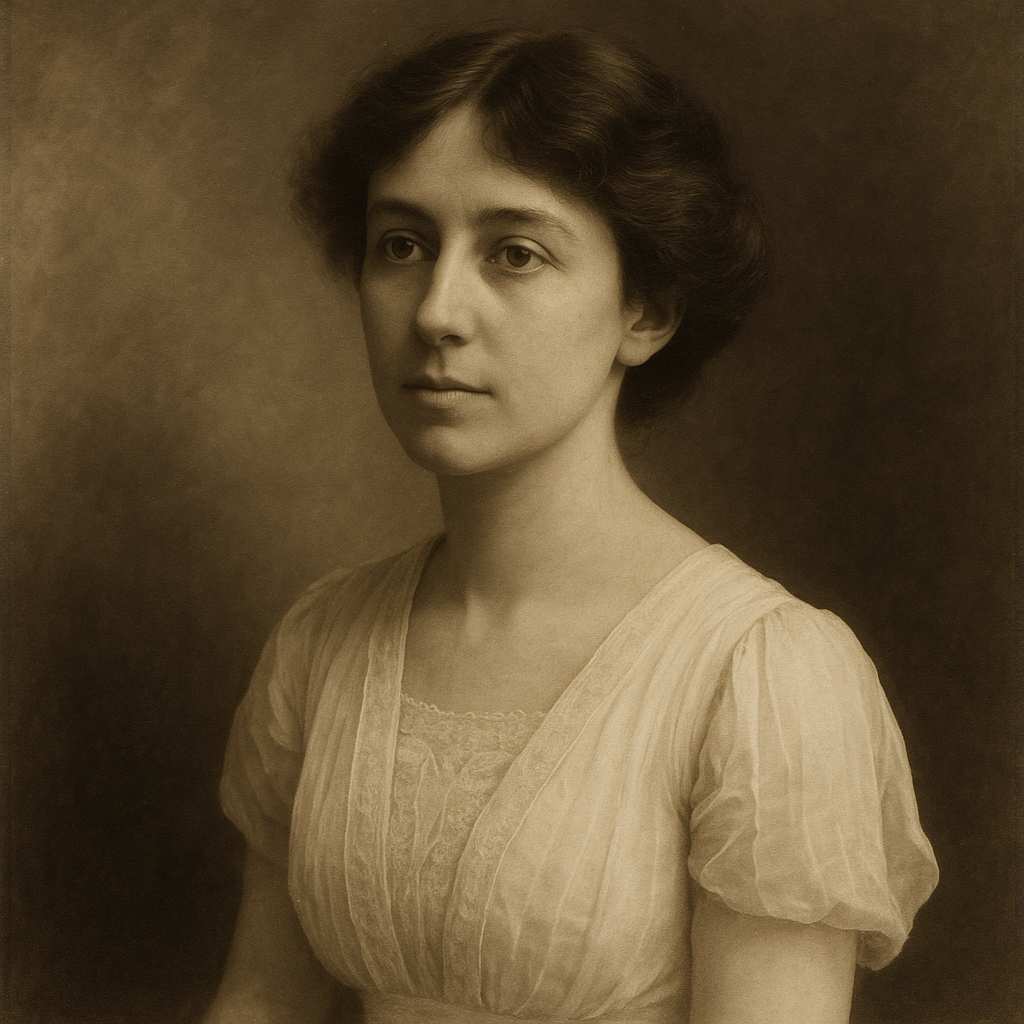4 Poems by Sara Teasdale
1884 - 1933
Sara Teasdale Biography
Sara Teasdale, born on August 8, 1884, in St. Louis, Missouri, emerged as one of the most delicate and deeply emotive poets of early 20th-century American literature. Known for her lyrical mastery, her poetry explores themes of love, nature, beauty, and mortality with a striking simplicity that belies the complex emotional currents beneath. Teasdale's life, much like her work, was marked by an acute sensitivity to the world around her, a sense of longing for both personal and universal connection, and a profound engagement with the fleeting nature of human experience.
Raised in a well-off family in St. Louis, Teasdale was the youngest of four children, born to a mother who had been 40 years old when she gave birth. Her frail health as a child meant she was often sheltered and protected, which contributed to her introspective nature and an early engagement with books. Teasdale didn’t attend school until she was nine, having been homeschooled for most of her early years. This seclusion likely fostered the deep romanticism and yearning for beauty that characterises her later poetry. Once enrolled in formal education, she attended the Hosmer Hall, a private girls' school where her literary inclinations began to blossom.
In 1907, her first poetry collection, Sonnets to Duse and Other Poems, was published. The poems in this early work reflect a clear influence of Romanticism and Victorian poetics, particularly echoing figures such as Christina Rossetti. The collection’s title poem, inspired by the Italian actress Eleonora Duse, indicates Teasdale’s early fascination with the ideal of unattainable beauty and her tendency to infuse her poetry with a sense of the ethereal and the unreachable.
The early 1910s saw Teasdale’s reputation as a poet rise significantly, especially with the publication of Rivers to the Sea in 1915, a collection that solidified her lyrical voice. In this volume, Teasdale refined her technique, demonstrating a mastery over concise, musical lines that conveyed profound emotional intensity without slipping into sentimentality. Her poems, while often brief, were exquisitely wrought, and it was this economy of language that earned her the admiration of both critics and readers alike. In her work, Teasdale’s keen awareness of time’s passage and the fragility of human relationships is pervasive, themes she returned to frequently throughout her career.
Her personal life during this period was marked by a series of romantic entanglements that greatly influenced her poetry. Teasdale was courted by several men, most notably fellow poet Vachel Lindsay. Although deeply infatuated with Teasdale, Lindsay's more flamboyant style and itinerant lifestyle clashed with her need for emotional stability. Ultimately, Teasdale chose to marry Ernst Filsinger, a businessman, in 1914. This marriage, however, was less than idyllic; Teasdale’s poetic imagination had been drawn to the idea of love as a transcendent, spiritual ideal, yet her actual experience of it seemed to fall short of her artistic expectations. The tension between her idealised vision of love and the realities of her relationships is a key aspect of her work and personal life.
Teasdale’s relationship with Lindsay remains one of the more poignant subtexts of her life. Lindsay’s passion for her was unreciprocated, and he later tragically committed suicide in 1931, a fact that adds an element of pathos to the story of their friendship. Scholars often speculate on the psychological effect this unfulfilled relationship had on Teasdale, especially given her own tragic end.
Her poetic output continued to receive critical acclaim throughout the 1920s, and she became one of the most popular poets of her time. Her 1917 collection Love Songs was awarded the Columbia University Poetry Society Prize, which would later evolve into the Pulitzer Prize for Poetry, making her one of the first female poets to be honoured in this way. Love Songs encapsulates the hallmarks of Teasdale’s style: lyrical grace, emotional clarity, and a deep engagement with the inner world of the speaker. The collection navigates the tumult of romantic yearning and disillusionment with remarkable tenderness, and some of the poems within reflect an almost childlike simplicity that disguises a more profound meditation on love’s complexities.
While Teasdale's fame was considerable during her lifetime, she never sought the limelight and remained a private, introspective individual. In the later years of her life, Teasdale faced growing personal and emotional difficulties. Her marriage to Filsinger began to disintegrate, leading to their divorce in 1929. This separation marked a significant turning point in Teasdale’s life and work, as it plunged her into a period of deep melancholy and isolation. Her poetry from this period reflects a heightened sense of loneliness and a preoccupation with death. Works like Dark of the Moon (1926) and Strange Victory (1933) exhibit a marked shift towards darker themes, with an increasing focus on mortality and the inexorability of time.
The simplicity that had characterised much of Teasdale’s earlier verse became more pointedly a vehicle for expressing her despair and her awareness of life’s transience. In the poem “There Will Come Soft Rains” from Flame and Shadow (1920), she imagines a world where nature continues serenely in the aftermath of human self-destruction. The poem reflects both Teasdale’s affinity for nature and her growing disillusionment with human existence. It’s often interpreted as a reflection on the First World War and the fragility of human civilisation, yet it also reveals Teasdale’s deeper existential concerns.
Teasdale’s final years were marked by ill health, both physical and emotional. She suffered from frequent bouts of depression and was plagued by a sense of despair. Her last collection, Strange Victory, published posthumously, is suffused with a deep sadness and a preoccupation with death that seems to foreshadow her tragic end. In 1933, Teasdale took her own life by overdosing on sleeping pills. The act was a culmination of years of suffering, and her suicide, coming just two years after Lindsay's, casts a somber shadow over her life’s narrative.
Teasdale’s poetry, often dismissed as excessively sentimental in the decades following her death, has undergone a reevaluation in recent years. Contemporary scholars have begun to appreciate the subtlety of her emotional insight and the precision of her craft. Far from being merely a poet of love and longing, Teasdale is now recognised as a significant figure who grappled with the complexities of modern existence. Her verse, though delicate, carries with it an intensity of feeling that speaks to the vulnerability of the human condition.
What makes Sara Teasdale’s poetry particularly compelling is its universality. Her poems, while often rooted in personal experience, evoke emotions and experiences that resonate deeply with readers across generations. Her exploration of love, loneliness, and mortality is timeless, and her ability to capture fleeting moments of beauty and sorrow with such economy of language is a testament to her skill as a poet. In her best work, Teasdale reminds us of the fragility of life, the inevitability of loss, and the enduring beauty of the world despite its impermanence.
Today, Teasdale occupies an important place in the canon of early 20th-century American poetry. Her lyricism, emotional depth, and thematic concerns continue to inspire and move readers, offering an intimate glimpse into the mind of a poet who, despite her struggles, never lost her ability to find beauty in a transient world. In a literary landscape often dominated by more grandiose or experimental voices, Teasdale’s quiet, melodic verse serves as a poignant reminder of the power of simplicity, sincerity, and introspection in poetry.
This text was generated by AI and is for reference only. Learn more
Username Information
No username is open
Everything is free to use, but donations are always appreciated.
Quick Links
© 2024-2025 R.I.Chalmers (V2Melody).

All music on this site by R.I.Chalmers (V2Melody) is licensed under a Creative Commons Attribution-NonCommercial 4.0 International License.
Attribution Requirement:
When using this music, you must give appropriate credit by including the following statement (or equivalent) wherever the music is used or credited:
"Music by R.I.Chalmers (V2Melody) – https://v2melody.com"
Support My Work:
If you enjoy this music and would like to support future creations, your thanks are always welcome but never required.
Thanks!





